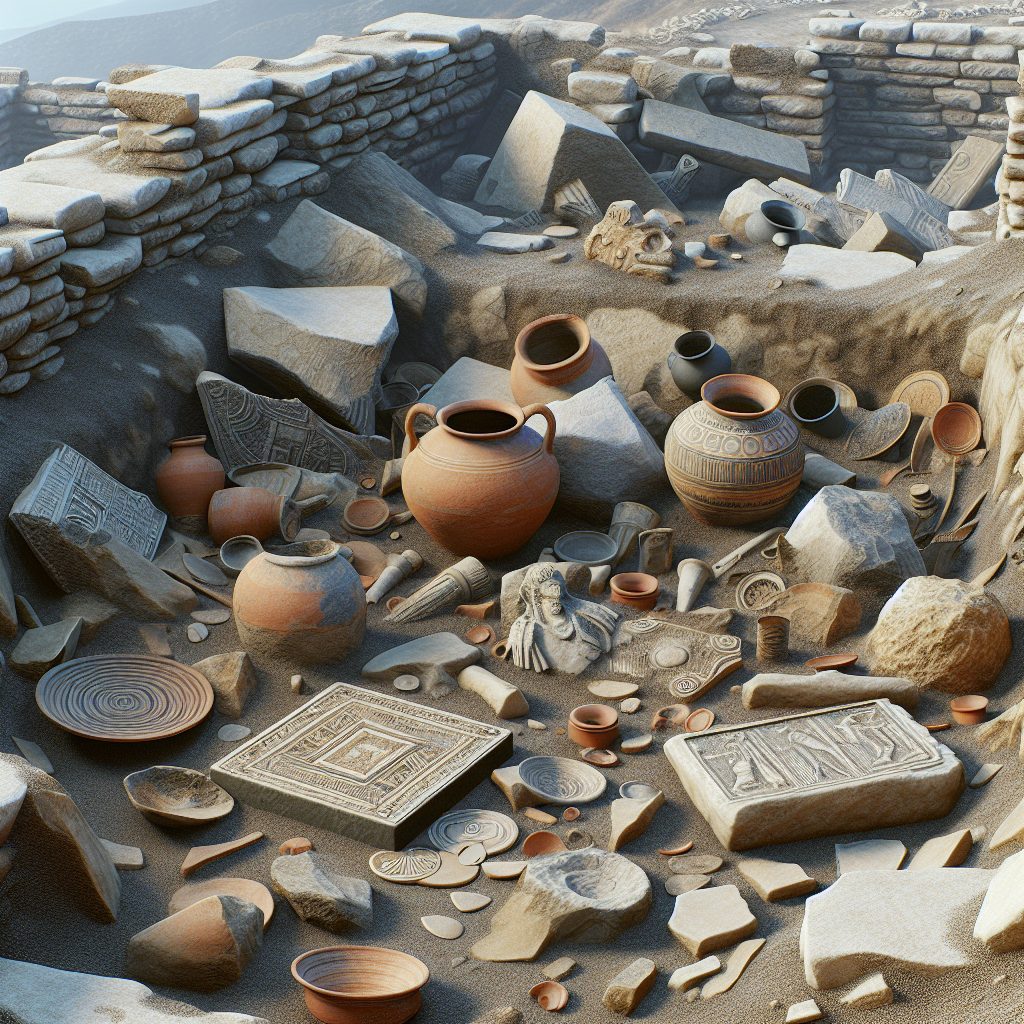Tharros archaeological site is a captivating historical gem nestled along the stunning Sardinian coastline. Steeped in ancient history, Tharros offers an unparalleled glimpse into the rich cultural heritage of the past. Fascinatingly, Tharros was once a flourishing Phoenician city, serving as a vibrant hub of trade and commerce during the 8th century BC. Its strategic location along the western coast of Sardinia allowed it to thrive as a maritime center, attracting diverse populations and fostering a unique blend of cultures. One of the most awe-inspiring aspects of Tharros is its remarkably well-preserved ruins, which provide invaluable insights into the lives of the people who once inhabited this ancient city.
The impact of Tharros archaeological site is felt both on a historical and cultural level. The ruins themselves, which include a temple, city walls, ancient baths, and an amphitheater, serve as a vivid testimony to the impressive architectural achievements of the past. Exploring the site, one can appreciate the advanced engineering techniques employed by the Phoenicians, allowing for the construction of monumental structures that have stood the test of time. Not only do these ruins offer a window into the past, but they also contribute to our understanding of ancient civilizations, their artistic traditions, and the complex networks of trade that spanned the Mediterranean.
In the upcoming sections, we will delve deeper into the key takeaways from Tharros archaeological site. From its historical significance as a strategic outpost in the ancient world to its unique features that continue to captivate modern-day visitors, we will explore the secrets and wonders that lie within Tharros. Discover the cultural collision that shaped this archaeological site and gain a deeper appreciation for the importance of preserving our shared heritage. Join us on this captivating journey through time and uncover the mysteries that Tharros has to offer.
Key Takeaways
1. Tharros archaeological site is located on the western coast of Sardinia, Italy, and offers a fascinating glimpse into the ancient Phoenician and Roman civilizations that inhabited the area.
2. The site’s strategic location by the sea, natural harbor, and impressive acropolis make it a historically important settlement dating back to the 8th century BCE.
3. Excavations at Tharros have unearthed various artifacts, including Phoenician and Punic ceramics, Roman mosaics, and ancient buildings, revealing the rich cultural and economic influences in the region.
4. The city’s decline can be attributed to a combination of factors, including the Vandal invasion in the 5th century CE and natural calamities such as floods, leading to its eventual abandonment.
5. Today, Tharros stands as an open-air museum, attracting tourists and history enthusiasts who can explore the ruins, walk along the ancient streets, and witness the remarkable preservation of this ancient civilization.
What is the significance of the Tharros archaeological site?
History of Tharros
Tharros, an ancient Phoenician city, has a rich history dating back to the 8th century BC. It was initially founded by the Phoenicians but later came under the control of various civilizations including the Carthaginians and the Romans. The city flourished as a major port and trading hub, playing a significant role in the Mediterranean region.
Archaeological Discoveries
The Tharros archaeological site has provided archaeologists with a treasure trove of valuable discoveries. Excavations have unearthed remarkable ruins, structures, and artifacts that shed light on the ancient Phoenician and Roman civilizations. These findings include ancient homes, temples, fortifications, and even a Roman theater. The site’s well-preserved ruins allow visitors to imagine what life was like during its prime.
The Phoenician Influence
Tharros offers a unique glimpse into the Phoenician culture and civilization. The presence of Phoenician relics and inscriptions in the area helps researchers better understand the Phoenician language, trade networks, and religious practices. The site’s strategic location on the coast also highlights the Phoenicians’ seafaring expertise and their significance in Mediterranean trade.
Roman Heritage
Following the Phoenician era, Tharros became part of the Roman Empire. The Roman occupation left its mark on the site, with the construction of impressive structures like the Roman theater. These remnants showcase Roman engineering prowess and their cultural impact on the region. The Roman ruins provide insights into the lifestyle, social structure, and artistic achievements of the time.
Visiting Tharros
For history enthusiasts and archaeological buffs, a visit to the Tharros archaeological site is a must. Exploring the ancient ruins, walking through the streets once bustling with activity, and admiring the architectural wonders are remarkable experiences. Guided tours are available to provide in-depth insights into the site’s history and significance. Don’t miss the opportunity to witness the remnants of past civilizations and immerse yourself in the captivating atmosphere of Tharros.
Top Tips for Exploring Tharros
- Plan your visit during the cooler months to fully enjoy exploring the site.
- Wear comfortable walking shoes as you’ll be navigating uneven terrain.
- Bring a camera to capture the stunning views of the ruins and the surrounding coastal landscape.
- Consider hiring a knowledgeable guide to enhance your understanding of Tharros’ history.
- Take time to appreciate the intricate details of the ancient architecture and sculptures.
- Pack sunscreen, a hat, and plenty of water to stay protected and hydrated during your visit.
- Combine your trip to Tharros with visits to other nearby archaeological sites to delve deeper into the region’s history.
Frequently Asked Questions
What is the significance of Tharros archaeological site?
Tharros archaeological site is an incredibly significant historical site in Sardinia, Italy. It dates back to the Phoenician period and is considered one of the most important ancient cities of the Mediterranean. The site provides valuable insights into the ancient civilizations that once thrived in this region.
How can I visit Tharros archaeological site?
The Tharros archaeological site is open to the public for visitation. It is advisable to check the opening hours and any special restrictions beforehand. To get there, you can take a taxi, rent a car, or use public transportation. There are also guided tours available for a more informative visit.
What are the notable features of Tharros archaeological site?
Tharros archaeological site boasts several remarkable features. These include well-preserved ruins of ancient Phoenician and Roman buildings, such as temples, theaters, and residential complexes. The site also overlooks the beautiful Mediterranean Sea, providing a stunning backdrop to the impressive historical structures.
Are there any guided tours available at Tharros archaeological site?
Yes, guided tours are available at Tharros archaeological site. These tours are led by knowledgeable guides who provide detailed information about the history, architectural significance, and cultural aspects of the site. Guided tours can enhance your experience and deepen your understanding of Tharros.
Can I take photographs at Tharros archaeological site?
Photography is generally allowed at Tharros archaeological site for personal, non-commercial use. However, it is always advisable to check with the site authorities for any specific photography restrictions or limitations. Remember to be respectful of the site and avoid causing any damage to the ancient structures.
Is Tharros archaeological site accessible for individuals with disabilities?
Tharros archaeological site may pose some challenges for individuals with disabilities due to the uneven terrain and ancient structures. However, efforts have been made to improve accessibility, including ramps and designated pathways. It is recommended to contact the site authorities in advance to inquire about specific accessibility accommodations.
What are the nearby attractions to Tharros archaeological site?
Tharros archaeological site is located in a stunning coastal area of Sardinia. Nearby attractions include beautiful beaches, such as Is Arutas and San Giovanni di Sinis, which offer opportunities for relaxation and swimming. There are also other archaeological sites in the vicinity, like the Nuragic Complex of Santa Cristina.
What facilities are available at Tharros archaeological site?
Tharros archaeological site offers basic facilities for visitors, including parking spaces, restrooms, and information boards. As the site is located in an outdoor setting, it is advisable to bring water, sunscreen, and comfortable footwear. There are also nearby cafes and restaurants where you can have a meal or refreshments.
Can I purchase souvenirs at Tharros archaeological site?
Yes, there is a small souvenir shop at Tharros archaeological site where you can find various items related to the historical significance of the site. These may include books, postcards, replicas of artifacts, and handmade crafts. Purchasing souvenirs can be a wonderful way to support the preservation of the site.
Is Tharros archaeological site suitable for children?
Tharros archaeological site can be an educational and interesting experience for children. However, it is advisable to keep in mind that the site involves walking and might not offer as many interactive activities specifically catered to children. Providing them with some background information beforehand can enhance their understanding and engagement.
Final Thoughts
The Tharros archaeological site is a true gem that offers a mesmerizing glimpse into the past. Walking through its ancient ruins is like stepping back in time and imagining the lives of those who once inhabited this vibrant city. The architectural splendor and historical significance of Tharros are truly awe-inspiring.
Visiting Tharros archaeological site not only allows us to appreciate the rich heritage of Sardinia but also encourages us to respect and preserve the remnants of our ancient civilizations. It is a place where history comes alive, and each stone tells a story. Exploring Tharros is a captivating journey that leaves a lasting impression and instills a sense of wonder about our ancestors and their remarkable achievements.






